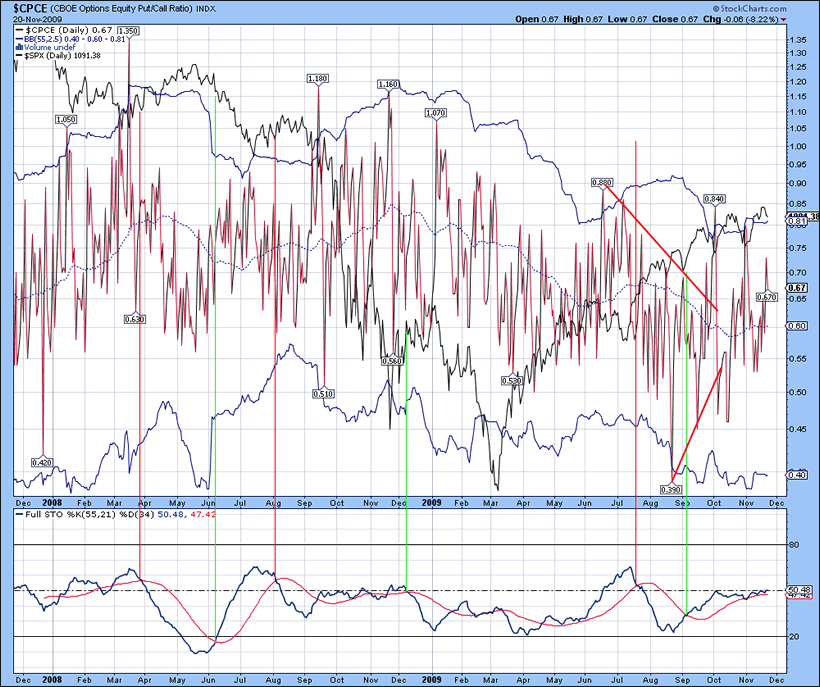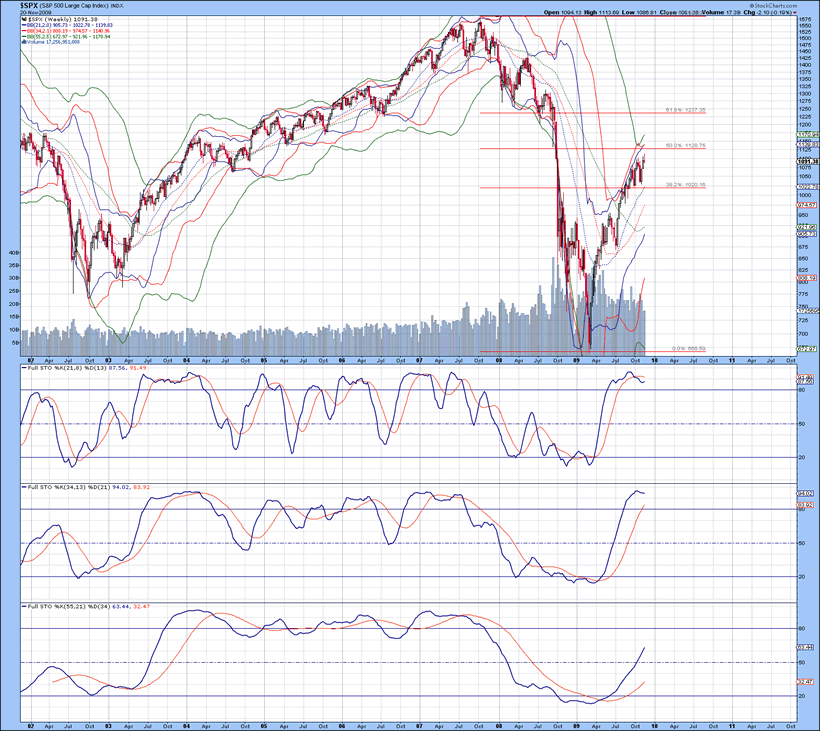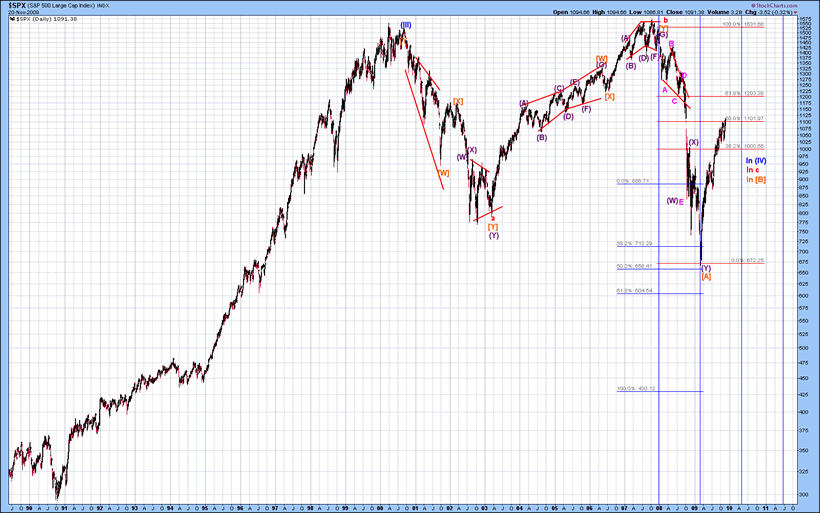Stock Market S&P 500 Trend Analysis and Forecast Update
Stock-Markets / Stock Index Trading Nov 23, 2009 - 10:06 AM GMTBy: David_Petch
 The following article was published for the benefit of subscribers on Saturday November 23rd 2009. All indices and commodities are trading inversely to the US dollar index at present, so as long as the defined trend of the USD remains intact, everything else should trade inversely. Gold is presently in a parabolic move, which has repercussions mentioned a few days earlier…on to analysis of the S&P 500 index:
The following article was published for the benefit of subscribers on Saturday November 23rd 2009. All indices and commodities are trading inversely to the US dollar index at present, so as long as the defined trend of the USD remains intact, everything else should trade inversely. Gold is presently in a parabolic move, which has repercussions mentioned a few days earlier…on to analysis of the S&P 500 index:
The daily chart of the Gold miner’s bullish percentage index is shown below, with the HUI shown in green. Full stochastics 1, 2 and 3 are shown below in order of descent, with the %K above the %D in 1 and beneath the %D in 2 and 3. Based upon positioning of stochastics 2 and 3, it appears that there may be a pause in the degree of bullishness.
Figure 1

The daily chart of the CBOE options equity put/call ratio is shown below, with the S&P 500 index shown in black. The put call ratio is forming another pennant formation (lines not drawn), indicating the possibility of a breakout to the upside or downside in the not too distant future. The full stochastic shown below (longer-term setting) has the %K marginally above the %D…notice how the %K and %D have been intertwined for most of November; a break of the %K beneath the %D would be bullish, while an increased angle of ascent above the %D would be bearish.
Figure 2

The daily chart of the S&P 500 index is shown below, with all three upper Bollinger bands in close proximity to each other, suggestive that further downside pressure could persist into next week. Full stochastics 1, 2 and 3 are shown below in order of descent, with the %K above the %D in stochastics 1 and 2 and beneath the %D in 3. It is possible the S&P 500 index declines to 1040-1050 this week or next before setting up the stage for “the Santa Claus Rally”.
Figure 3

The weekly chart of the S&P 500 index is shown below, with the upper 21 and 34 MA Bollinger bands in close proximity to each other. Lower Bollinger bands continue to rise up to the index; the lower 55 MA BB curled down recently, confirming the November breakout and when it curls back up, a top will have been put in place. The lower 21 MA BB is still at quite a low level relative to the index, suggestive that more time is required for it to get within close proximity to see enough reduction in volatility to trigger a downward move. Full stochastics 1, 2 and 3 are shown below in order of descent, with the %K above the %D in 2 and 3 and beneath the %D in 1…the %K in stochastic 1 appears to be hooking up (or at least trying). Based upon the length of the upward trend in the S&P 500 index, a top cannot be precisely determined until the %K in stochastic 2 falls beneath the %D. The %K in stochastic 3 is well above the %D, with no indication that a top has been put in place. For now, the weekly chart of the S&P 500 index suggests the upward trend remains intact.
Figure 4

The monthly chart of the S&P 500 index is shown below, with all three lower Bollinger bands falling beneath the index, suggestive that an important bottom was put in place in 2008. Full stochastics 1, 2 and 3 are shown below in order of descent, with the %K above the %D in 1 and beneath the %D in 2 and 3. Based upon positioning of the %K in stochastic 3, it could take another 12-16 months before the next bottom is put in place. The monthly chart suggests the S&P 500 index is in an uptrend and until the %K in stochastic 1 begins to roll over, nothing more need be said.
Figure 5

The mid-term Elliott Wave count of the S&P 500 index is shown below, with the thought pattern forming denoted in green. The S&P could fall back to 1040-1050 over the course of the next week before grinding higher. I am anticipating a top around the end of 2009, but I again stress that it could very well be stretched out into late February/early March 2010 before topping out.
Figure 6

The long-term Elliot t Wave count of the S&P 500 index is shown below, with vertical lines marking the time wave [A] took to form. Based upon this observation, wave [B] MUST go until late April to be considered a correct count, otherwise wave [A] becomes wave [W] and the present move up is wave [X]. If wave [X] were to happen, it should retrace 61.8% of the decline or move to just above 1200…if the wave [B] scenario is correct, the S&P should rally into April. Either or, until proven otherwise, the S&P has further upside or further sideways action so until either of the above scenarios develop (if 1200 is hit, exit all trading positions accordingly), the upward trend of this move remains intact.
Figure 7

By David Petch
http://www.treasurechests.info
I generally try to write at least one editorial per week, although typically not as long as this one. At www.treasurechests.info , once per week (with updates if required), I track the Amex Gold BUGS Index, AMEX Oil Index, US Dollar Index, 10 Year US Treasury Index and the S&P 500 Index using various forms of technical analysis, including Elliott Wave. Captain Hook the site proprietor writes 2-3 articles per week on the “big picture” by tying in recent market action with numerous index ratios, money supply, COT positions etc. We also cover some 60 plus stocks in the precious metals, energy and base metals categories (with a focus on stocks around our provinces).
With the above being just one example of how we go about identifying value for investors, if this is the kind of analysis you are looking for we invite you to visit our site and discover more about how our service can further aid in achieving your financial goals. In this regard, whether it's top down macro-analysis designed to assist in opinion shaping and investment policy, or analysis on specific opportunities in the precious metals and energy sectors believed to possess exceptional value, like mindedly at Treasure Chests we in turn strive to provide the best value possible. So again, pay us a visit and discover why a small investment on your part could pay you handsome rewards in the not too distant future.
And of course if you have any questions, comments, or criticisms regarding the above, please feel free to drop us a line . We very much enjoy hearing from you on these items.
Disclaimer: The above is a matter of opinion and is not intended as investment advice. Information and analysis above are derived from sources and utilizing methods believed reliable, but we cannot accept responsibility for any trading losses you may incur as a result of this analysis. Comments within the text should not be construed as specific recommendations to buy or sell securities. Individuals should consult with their broker and personal financial advisors before engaging in any trading activities as we are not registered brokers or advisors. Certain statements included herein may constitute "forward-looking statements" with the meaning of certain securities legislative measures. Such forward-looking statements involve known and unknown risks, uncertainties and other factors that may cause the actual results, performance or achievements of the above mentioned companies, and / or industry results, to be materially different from any future results, performance or achievements expressed or implied by such forward-looking statements. Do your own due diligence.
Copyright © 2009 treasurechests.info Inc. All rights reserved.
Unless otherwise indicated, all materials on these pages are copyrighted by treasurechests.info Inc. No part of these pages, either text or image may be used for any purpose other than personal use. Therefore, reproduction, modification, storage in a retrieval system or retransmission, in any form or by any means, electronic, mechanical or otherwise, for reasons other than personal use, is strictly prohibited without prior written permission.
David Petch Archive |
© 2005-2022 http://www.MarketOracle.co.uk - The Market Oracle is a FREE Daily Financial Markets Analysis & Forecasting online publication.



